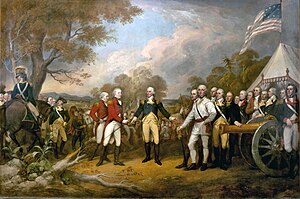
Back حملة ساراتوجا Arabic Campanya de Saratoga Catalan Saratogafelttoget Danish Saratoga-Feldzug German Campaña de Saratoga Spanish Saratoga kampaania Estonian Campagne de Saratoga French Kampanye militer Saratoga ID Campagna di Saratoga Italian サラトガ方面作戦 Japanese
| Saratoga campaign | |||||||
|---|---|---|---|---|---|---|---|
| Part of the American Revolutionary War | |||||||
 Surrender of General Burgoyne a portrait by John Trumbull | |||||||
| |||||||
| Belligerents | |||||||
|
Oneida |
Iroquois (minus Oneida) | ||||||
| Commanders and leaders | |||||||
|
|
Charles de Langlade | ||||||
| Strength | |||||||
| 25,000[3] |
8,500 (Burgoyne)[4] 1,600 (St. Leger)[5] 3,000 (Clinton)[6] | ||||||
| A Campaign streamer embroidered "Saratoga 2 July–17 October 1787" is awarded to American military units that participated in this campaign. | |||||||
The Saratoga campaign in 1777 was an attempt by the British high command for North America to gain military control of the strategically important Hudson River valley during the American Revolutionary War. It ended in the surrender of the British army, which historian Edmund Morgan argues, "was a great turning point of the war, because it won for Americans the foreign assistance which was the last element needed for victory."[7]
The primary thrust of the campaign was planned and initiated by Lieutenant General John Burgoyne. Commanding a main force of some 8,000 men, he moved south in June from Quebec, boated south on Lake Champlain to Fort Ticonderoga and from there boated south on Lake George, then marched down the Hudson Valley to Saratoga. He initially skirmished there with the Patriot defenders with mixed results. The turning point of the campaign happened in August at the Battle of Bennington when militia forces from Vermont, New Hampshire, and Massachusetts defeated, killed, and captured around 1,000 Brunswicker and Hessian troops from Burgoyne's army. Then, after losses in the Battles of Saratoga in September and October, his deteriorating position and the ever-increasing size of the American army forced him to surrender his forces to the American general Horatio Gates on October 17.[8]
In this critical British loss on the field of battle, the coordinated movements that had been drawn up in far away London did not materialize. Colonel Barry St. Leger had been assigned to move east through the Mohawk River valley on Albany, New York, but was forced to retreat during the siege of Fort Stanwix after losing his Indian allies. The major expedition planned from the south was not launched due to miscommunication with London when General William Howe sent his army to take Philadelphia rather than sending it up the Hudson River to link up with Burgoyne. A last-minute effort to reinforce Burgoyne from New York City was made in early October, but it was too little, too late.
The American victory was an enormous morale boost to the fledgling nation. More importantly, it convinced France to enter the war in alliance with the United States, openly providing money, soldiers, and munitions, as well as fighting a naval war worldwide against Britain.
- ^ Ottawas, Fox, Mississauga, Chippewa, Ojibwe, Huron, Nipissing First Nation
- ^ Edmund Morgan, The Birth of the Republic: 1763–1789 (1956) pp. 82–83
- ^ This number estimates the total number of American combatants involved in the campaign. While Nickerson details a significant number of the troop counts during the campaign (pp. 435–451), Pancake (1977) provides a more ready source of numbers for recruitments. The Northern Department (under Schuyler and then Gates) started with about 5,500 men (Pancake, pp. 151–152), and the Highland Department under Putnam, based on troop deployments ordered, had about 3,000 men (pp. 153,180). Militia recruitment after the fall of Ticonderoga and the killing of Jane McCrea was substantial: known recruitments included Stark and Warner 2,000 (p. 153), Lincoln 1,500 (p. 178), and Herkimer 800. Gates had 15,000 to 18,000 men when Burgoyne surrendered (p. 189), which did not include about one-half of Putnam's and Stark's men, the Mohawk River outposts, Herkimer's troops, or earlier losses due to battle, disease, or expiring enlistments. It did include Morgan's 300+ riflemen, dispatched from Washington's main army. Considering that Putnam's forces were also swollen by militia following the Battle of Forts Clinton and Montgomery (one British report claimed 6,000 men were following them on October 16, Pancake p. 188), the number of Americans in the field in mid-October was probably well over 20,000.
- ^ Nickerson (1967), p. 437, and other sources report Burgoyne starting with 7,800 men. Nickerson notes (p. 105) that this number does not include officers, non-combatant staff, and camp followers, who would also require supplies. That number also does not include Indians and Loyalists who arrived after the capture of Ticonderoga (about 700, Nickerson p. 439).
- ^ See siege of Fort Stanwix for details.
- ^ See Battle of Forts Clinton and Montgomery for details. This number includes all troops Clinton sent north from New York, not all of which were involved in battle.
- ^ Edmund Morgan, The Birth of the Republic: 1763–1789 (1956) pp. 82–83
- ^ Griswold, William A.; Linebaugh, Donald W. (2016). The Saratoga Campaign : uncovering an embattled landscape. Lebanon, NH. ISBN 9781611688962.
{{cite book}}: CS1 maint: location missing publisher (link)
© MMXXIII Rich X Search. We shall prevail. All rights reserved. Rich X Search